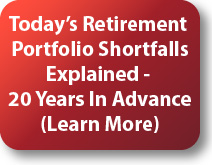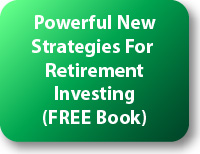Growing Wealth With Stocks: Expectations vs The New Reality
by Daniel R Amerman, CFA
Below is the 2nd half of this article, and it begins where the 1st half which is carried on other websites left off. If you would prefer to read (or link) the article in single page form, the private one page version for subscribers can be found here:
Five Fundamental Changes
Five fundamental changes have transformed the US economy and the US financial system since the late 1990s.
The first change dates back to the mid to late 1990s, as a theory called globalization increasingly gained primacy. Trade barriers were reduced and more goods were purchased from overseas, replacing goods that had previously been made in the United States. The trade deficit exploded within a few years, even as China began perhaps the most phenomenal economic expansion in modern times.
There was a drop in the price of many basic goods – along with a corresponding drop in manufacturing employment -- as entire industries began to move overseas. Much of the retail industry continued to consolidate into national chains of "big box" stores that could buy on a bulk basis from offshore manufacturers, squeezing out many of the remaining local retailers and their middle class owners.
It may be no coincidence that it was during the time period shortly after globalization began to accelerate, that employment growth effectively stopped in the United States. As covered in my article "Making 9 Million Jobless "Vanish": How The Government Manipulates Unemployment Statistics" (linked below), since the year 2000, the number of Americans age 16 and above has risen by 30 million people. Based on workforce participation rates from the 1970s to 2000, about 2/3 of them should have joined the workforce, which means that in a "normal" economy, about 20 million more jobs would need to have been created in order to maintain stable employment levels.
http://danielamerman.com/articles/2012/WorkC.html
Instead, however, we now actually have fewer full-time jobs than we did in 2000, which means we have over a 20 million job shortfall. Now, government statisticians can play all the definitional games they want in order to report a headline unemployment rate of under 8%, but on a fundamental basis, there is no getting around that 30 million more people of employment age - combined with no new full time jobs on a net basis - means that a massive change has in fact occurred at the very foundation underlying both society and the economy.
During this same time period, the financial regulations that had been in place since the 1930s, such as Glass-Steagall - regulations that were intended to put restraints on financial institutions - were in large part stripped away. Major banks were now more free than they had been since the 1920s to take massive financial risks in the pursuit of corporate profits and individual bonuses. This was also the same time (by no coincidence, I would argue) that we saw the explosive growth in the derivatives markets.
It was in this time interval as well that we saw the US financial system become increasingly dominated by bubbles growing and then popping. We had the tech stocks bubble that grew massively and then popped. This was replaced by a real estate bubble that soared upward, popped and nearly took the nation's economy down with it, with the damage being compounded by the risky games being played with derivatives on the part of major banks in the search for short-term profits and bonuses.
The fifth fundamental change was the expanding role of the United States government and the Federal Reserve, in the form of damage control. Deficits exploded, as an ever larger share of the national economy grew dependent upon government spending. To contain the financial damage, the Federal Reserve began creating trillions of dollars out of the nothingness, while manipulating interest rates downward to near zero levels.
So when we look at these five major changes in combination, we can see that a powerful, near complete transformation of the US economy and financial system has occurred over the last 15 years.
Now if we accept this new reality of a fundamentally transformed economy and financial system, a question to ask is, how good a predictor have stock market results from the second half of the 20th Century turned out to be? Can we indeed just take the past, project it forward, and assume that historical stock returns will endlessly and reliably reproduce themselves over the long term?
As found in the three different tests herein, real-world financial results of the past 15 years do not support this claim. To the contrary, there has been relatively little compounding of wealth when compared to historical levels. Instead, there is in fact a market that is moving more or less sideways, with a vastly reduced compounding of wealth rather than reliably growing over time.
This lack of performance is particularly crucial when we consider the downward drag of fees and taxes, which are not included in the analyses. There is also the issue of the methodology of how inflation rates are calculated, which like the calculation of unemployment rates, have been a moving target over the last several decades. If we include financial fees and taxes, and we move the real inflation rate up just a percentage point or two to come closer to how inflation was calculated in the 1970s and 1980s - then it is a short journey to get to the point that there has been no real wealth compounding at all, but rather there have been negative returns over the last 15 years in after-tax and after-inflation terms.
The Compounding Of Wealth
As has been well understood for centuries, when it comes to the short term - stock investments can be lucratively profitable, and they can also hold major risks. We all take our chances.
In recent decades, however, a quite different theory of stocks has become prevalent, as has a quite different rationale for average investors buying stocks. The theory is that with a sufficiently long investment horizon, there will effectively be a "free lunch" with stock investments (more technically known as an "equity premium"), where the risk drops out and the superior returns remain, when compared to other asset classes.
One of numerous problems with this theory is we are in a very different world than we used to be. This is true of society, this is true of culture, and this is true of technology. We live in a globalized world where US employment effectively stopped growing 20 million jobs ago, where financial risks to the system are far higher, and where the economy depends on deficit-financed massive government spending, even as the markets are driven more by the degree of Federal Reserve interventions than they are by free market fundamentals.
This is an upside down world when compared to the world of the previous century. And when we take a close look at stock investment performance in real terms since this last round of major changes transformed our economic and financial system – the strongly positive results simply haven't been there like the theory said they would be.
Classic financial planning is based on a mixture of primarily equity investments, fixed income investments and a few alternative investments thrown in as well. We're supposed to get a fair market return on our bonds and other interest-bearing investments that will compound wealth for us over time with lesser price risk. We're supposed to get higher returns with our stock investments, albeit accepting somewhat greater year-to-year price risk. So we follow the classic formula of the Investment Life Cycle: we start stock-heavy, and we slowly shift to bonds over time until we build enough wealth where our bond interest payments will comfortably and reliably support us in retirement.
That's how it's supposed to work.
Instead, we are in an environment where due to direct and massive government interventions which are being used to override market forces, interest rates are some of the lowest they've been in history. So the long time theory that fixed income investments will compound wealth and reliably generate sufficiently significant interest payments to comfortably support our retirement is not working out for many tens of millions of people.
At the same time, instead of reliably compounding wealth, stocks are strongly underperforming on an inflation-adjusted basis when it comes to prices, even as dividend levels are some of the lowest in history. That lack of real price appreciation and low dividend levels in combination also means that stock wealth is not substantively compounding as expected.
So, neither of the two pillars of reliably growing substantive new wealth using classic long-term financial planning strategies - neither stocks nor interest payments - has been working in practice in our new reality. And the real world results are changing daily lifestyles for current retirees, and moving back the planned retirement age for large numbers of people.
There is a truism about military history, which is that generals (and nations) have at times been surprised by losses in the initial battles of a new war, because their strategies are based on successful ones from previous wars. The world changes. So what on paper should have produced brilliant victories had the previous war been fought again - instead become devastating and unexpected losses in the new reality of a new war being fought under very different conditions.
This is an apt analogy for long-term investing today. All around us, tens of millions of people are following investment strategies for compounding wealth that are based upon the economy and financial system of previous decades. On paper, these strategies can appear to work great - if only the past would continue to repeat itself.
Except that the world, the economy and the financial system have changed. In practice, then, we have a huge failure to perform when it comes to the compounding of stock wealth in real terms, as well as the ability to use interest payments to support a retirement lifestyle.
We can accept a new reality, strive to understand that reality, and seek out quite different strategies for a very different time in the world. Or we can continue to invest in yesterday's world, based on a theory that hasn't been working out too well for quite a while now. The choice is each of ours.







